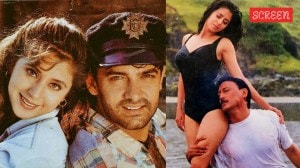ASI: history to politics
On Tuesday the Bhojshala-Kamal Maula Masjid in Dhar was thrown open to Hindus on the order of the Director General of the Archaeological Sur...

On Tuesday the Bhojshala-Kamal Maula Masjid in Dhar was thrown open to Hindus on the order of the Director General of the Archaeological Survey of India, Gauri Chatterjee. In the calculus of losses and gains, with both the state government and the Sangh Parivar giving their own spin to the narrative, a recap of the events shows neither side has much to write home about. The incident has also damaged the credibility of the ASI as an independent institution.
The problem resurfaced this year after Dhar had been quiet for over five years. In 1997, after repeated trouble at the site, stirred up by the Bajrang Dal post-1992, the state administration had imposed restrictions, that were upheld by an ASI order prohibiting access to the monument except for namaz between 1 and 3 p.m. on Fridays for Muslims and worship by Hindus on Vasant Panchami.
This has been set out in an April-1998 reply to a writ in the Indore High Court, that was filed on behalf of the Secretary, Department of Culture, and the Superintending Archaeologist, Bhopal Circle. This is the official ASI stand on the issue that has so far not been contradicted by it. According to the reply, question over rights to the monument were in 1952 ‘‘referred to the Department of Education and Local Self Government Madhya Bharat, which issued instruction … that the present structure called the Bhojshala and Kamal Maula Mosque, was an Archaeological Monument, and thus it could not be handed over to either the Hindus or Muslims…. The Muslim community may continue to offer their Friday Namaz …’’.
|
The only right to worship that existed upto 1952 was that of namaz by the Muslims on Friday. Another letter, dated 17 February 1953 in the court records, written by Jt Director General of Archaeology to the Dharmsthan Rakshak Committee in Dhar, states: ‘‘It is regretted that the Hindus cannot be allowed to perform the Bhoj Day celebrations in the Bhoj Shala at Dhar.’’
Going a step further, this letter proves that the Vasant Panchami worship now being claimed as a right by the Sangh did not take place as of 1953. The HJM on February 6 announced a programme for the ‘‘liberation’’ of the site.
At this stage that the Saffron Centre decided to interfere. On February 13, Minister for Tourism and Culture Jagmohan wrote to Digvijay Singh: ‘‘If the DM/State Government gives clearance from the point of view of law and order, the Department of Culture/ASIwould be happy to withdraw these restrictions….’’
On February 21, the Home department of the state submitted its reply to the ASI. While opinion had been sought only on withdrawing restriction, the state government actually proposed new concessions to Hindus. In the final order issued by the DG, ASI, the illegal concession advanced by the State was further modified.
The ASI replied: ‘‘the structure remains declared as the ancient protected monument for all its practicality it is neither temple nor a mosque in the eyes of the ASI, wherein it remains simply as a non-living protected Monument…not a temple of Saraswati but a mosque built by one Muhammed Shah Khilji…’’
Given that the ASI itself believes the monument in its present actual nature is a mosque it is difficult to see how the ASI has granted special permission of access to Hindus.
Photos


- 01
- 02
- 03
- 04
- 05




























